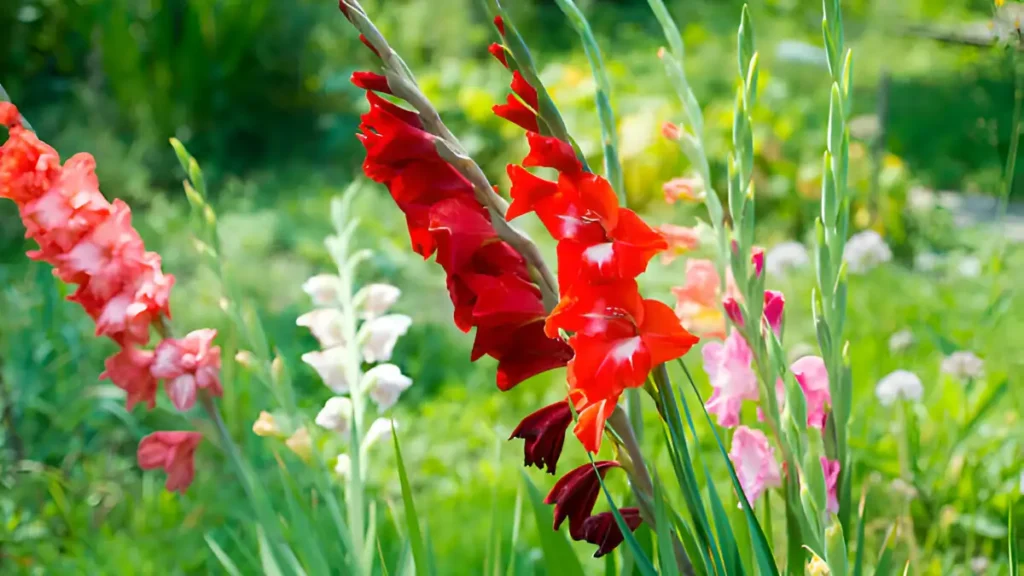Often called “sword lilies,” gladiolus flowers are a gardener’s paradise. They add unmatched elegance and appeal to any garden with their towering spikes of colorful blossoms. Although gladiolus cultivation calls for careful preparation and attention to detail, the outcome is a stunning floral arrangement. Here, we outline the best practices for cultivating gladiolus flowers and guaranteeing a successful garden.
Gladiolus bulbs, a South African archaic flower, are easy to grow and complement vibrant perennials. Their ruffled single florets can be easily cut and placed in bowls and vases. These bulbs are suitable for garden celebrations and can be sown in spring.
Gladiolus flower meaning:
Gladiolus flowers stand for moral character, power, and integrity. Known as the “sword lily” because of their long, blade-like stems, they also evoke adoration and remembering. These colorful blooms are popular for romantic gestures because they are linked to love at first sight and infatuation. Gladiolus flowers are also of special importance for people born in August because they are the birth flowers for that month.
Glads, or flowering plants, belong to the iris family and come in various sizes and colors, from small container-friendly hybrids to large-flowered Grandiflora hybrids with spikes of blooms.
Gladioli, varying sizes from miniature to giant, typically grow 2 to 5 feet tall. Taller plants require staking and are typically placed at the rear of a garden to balance out shorter plants.
When to plant gladiolus bulbs:
The best time to plant gladiolus bulbs, also known as corms, is in the spring, once the soil has warmed to at least 55°F (13°C) and the risk of frost has passed. From spring through early summer, space plantings every two weeks for continual flowering. Plant the corms 4 to 6 inches deep and spaced approximately 6 inches apart in a sunny spot with well-drained soil. Gladiolus produces gorgeous bursts of color all summer long, usually blooming 70 to 90 days after planting.
Learn how to plant gladiolus bulbs:
1. Getting the ideal soil ready for gladiolus
Gladiolus needs at least 6 to 8 hours of direct sunlight per day. Choose a spot that is not shaded and shielded from severe winds.
To improve soil quality, keep it to a minimum of 12 inches and add organic materials like old manure or compost. Bone meal can increase phosphorus levels, promoting root growth and colorful flowers. Test and modify pH levels using a soil test kit, adding sulfur or lime as needed.
2. How to choose and maintain gladiolus corms
To ensure a successful gladiolus garden, choose high-quality corms that are firm, plump, and free from blemishes or mold. Larger corms typically produce stronger plants with more blooms.
If planting is postponed, keep the corms somewhere dry and cool. To keep them from decaying, keep them away from dampness and direct sunshine.
3. Planting gladiolus corms
Gladiolus plants require proper planting time and depth for optimal growth. Plant corms 4-6 inches deep, pointing the pointed end up, 6-8 inches apart. Plant every two weeks from spring to early summer for uninterrupted bloom display. Thoroughly water the planting area after planting to settle soil and promote root formation.
Caring for gladiolus throughout the season:
- Especially when the weather is dry, keep the soil consistently moist—water at the base to prevent disease-causing damp foliage.
- When the shoots appear, apply a balanced fertilizer (10-10-10). When flower spikes start to appear, reapply. Steer clear of overfertilizing as this could result in too much foliage at the price of blossoms.
- To avoid toppling, gladiolus flowers frequently need assistance. Plant them close to fences or use stakes. Use delicate garden ties to carefully bind the stems.
- To lessen competition for nutrients, keep the area surrounding gladiolus clear of weeds. Mulching helps keep the soil moist and inhibit weed growth.
- Compost enhances soil for spring planting, followed by applying balanced, water-soluble fertilizer when plants reach 10 inches tall and when flowers display color.
- Gladiola can be grown as cut flowers or annuals, and after flowering, deadhead stems to prevent self-seeding in winter-strewn areas, and trim back remaining leaves for winter.
Winter protection for gladiolus:
- For winter protection, spread hay or straw in USDA Hardiness Zone 8 or higher, and gladiolus can remain in the ground without a hard freeze.
- Gladioli corms should be dug up in colder climates after the first fall frost, as the leaves may be killed by frost, but the plant will survive. Failure to dig up before a hard freeze can cause severe damage.
- Gardeners in border zones 6 and 7 have found gladiolus plants to survive when left in the ground, despite the decision based on microclimate and gladiolus variety.
Conclusion:
These comprehensive instructions will help you cultivate captivating and motivational gladiolus blooms. Gladiolus enhances any environment with unmatched beauty, whether it is used as a stand-alone feature or as part of a mixed garden.
Certainly! If you’d like to learn more, please consider following our WhatsApp Channel: Harvest Gardening
A frequently asked questions:
Q1: Where is the best place to plant gladiolus?
A1: Gladiolus should be planted in a sunny spot with soil that drains well and is high in organic matter. To prevent the long flower spikes from bending or shattering, make sure they are protected from severe winds.
Q2: Do gladiolus grow in summer or winter?
A2: Since gladiolus prefers warm climates, they usually develop and bloom throughout the summer. They are planted in the spring for summer blooms in mild climes, but they can also be planted in the fall for winter blossoms in warmer climates.
Q3: How to propagate gladiolus?
A3: Gladiolus is propagated by planting corms (bulb-like structures) or cormels (little corm offsets) in well-drained soil. To produce new plants during the dormant season, separate and transplant cormels.

